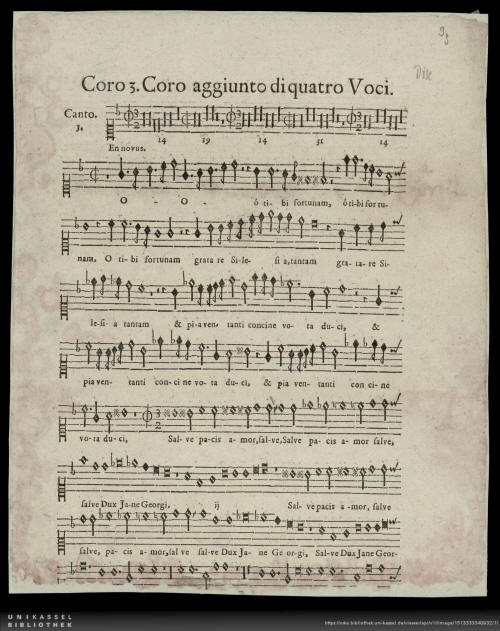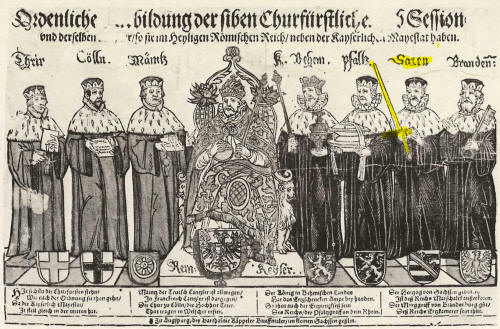Syncharma musicum (En novus Elysiis
)
Henrich Schütz (1585-1672)
SWV49 (1621)
- Motet written for a
political ceremony
in Breslau in 1621, during which the (rebellious, 'protestanticizing') Princes of the The Silesian Estates
("Stände") pledged their allegiance to the Elector Johann Georg I
(Duke of Saxony) who represented the Emperor of the Holy Roman Empire Ferdinand II.
- Motet composé à l'occasion des hommages rendus à Breslau (1621) par les États Silésiens au prince électeur de Saxe, le réprésentant de l'empereur Ferdinand II.
More on this occasion below the two recordings.
Official title: Syncharma musicum tribus Choris adornatum.. [full
title] = song of shared joy, set for three choirs
- syncharma
is a non-existent Latin
word, which combines an existent Greek noun:
carma [charma = joy] adding
sun [syn=together] as a prefix: a
symphony of shared joy, a concelebration.
- chorus, coro, choir =
ensemble of voices (sung and/or instrumental), i.c. three choirs of four
voices each.
| Coro I: Cornetto 1-2, Voce (Tenor),
Cornetto 3 Coro 2: Voce (Tenor) 3 bass-lines (instruments not specified by Schütz): keys Bariton/Bass/Subbass, e.g. dulcians/sackbuts. Coro 3: Coro aggiunto di quatro Voci: Canto 1-3, Basso (SSSB voices) Basso per l'Organo. à 3 Cori di H.Sag. : Continuo |
-
auf Deutsch: Das_Huldigungsmotet - Hintergrund und Übersetzung
Two performances. One by Capella Sagittariana Dresden (from a CD, with score, info and latin-english subs), the other a recording of a performance by Musica Vera (Paris)
Original text ( Latin)
Latin) |
 English
translation English
translationAuf Deutsch / Nederlands |
En novus Elysiis succedit sedibus hospes |
Behold, a new host accedes to the
Elysean thrones: the Duke of Saxony, swordbearer of the Roman Empire, to bring the gifts of the long-awaited peace to this region, and bind its subjected members with an oath of allegiance to the Emperor. in order that, with the enemies expelled, in every city will flourish the work that pleases God (religion) and the splendour of justice. O Silesia, rejoice that this great fortune comes to you, and seal your pious vows before the incoming duke: Hail love of peace, hail Duke Johann Georg: You grant us, and we honour (or ask for), your succour. |
The political ceremony for which this motet was written, took place in
november 1621 in Breslau (now Poland-Wroclaw, then a capital city of
Silesia). The Princes of the The Silesian Estates
("Stände") were gathered there in orde to pay homage to Elector Johann Georg I
(Duke of Saxony), who ex officio represented the Holy Roman Emperor Ferdinand II:
a homage by proxy.

Duke Johann Georg I
(the Elector prince of Dresden, Schütz's employer) had helped negotiate the peace after
the 'Bohemian Uprising'. Decisive had been the Emperor's victory over the rebellious Bohemian Princes,
at the "battle of the White Mountain"
(near Prague, 8 November 2020). Duke Johann Georg I (though
Luteran himself) who had fought for the Emperor in Lausitz, served as the emperor’s envoy for
the formal declaration of peace in Breslau
in november 1621. In the full
title the Duke of Saxony even gets the credits for the restoration
of peace (Interventu... pax reddetur). So this is not an anodyne piece of
music. It's political music of the highest order. The celebrated munera pacis (gifts of peace) were brought
to the region by force of arms. The oaths/vows of allegiance
(pia vota) are professed by
the emperor's subjects
(litterally:
subdita membra, subjected members);
the enemies whose expulsion (hostibus pulsis) is celebrated,
are the former allies of the Protestant League. Music was a political instrument, part of the court's
propaganda media. The main celebration took place on
3 November 1621. The text itself suggests that it might well have been performed
during the opening ceremony, while 'Johann Georg I' made his entry (ventanti duci).
The display of music during this kind of ceremonies enhanced the
display of power. More background below
It is often suggested that Schütz himself wrote the text (5 disticha, perfect hexameter/pentameter. He surely was capable). This sounds quite probable, especially since the - now lost - titlepage of the print edition quotes the entire text as a dedicatory poem, addressed to the Duke, by his faithful Kapellmeister, Henrich Schütz. That the music was simultaneously published in Breslau, also formed part of the media campaign. Henrich Schütz, the court musician. Contrary to what one commonly reads, there is no indication whatsoever that Schütz also wrote the 'German alternative text' (an adaptation of Psalm 124 to fit the notes). This is based on an unsubstantiated hypothesis of the editor of the Neue Schütz Ausgabe (1971), Werner Bittinger, who in this clearly belongs to the 'old-skool' Schütz' admirers. What are the facts? Well, there is (better: was) only one: In the now lost Breslau copy of the original edition (Breslau, 1621, Georg Baumann) this text was written 'with ink' below the printed Latin text (information provided by Philipp Spitta in his edition of Schütz's works, vol XV, introduction, p. VI). In the library of Breslau there were also handwritten copies of the parts with only the German text underlaid. Since 1943 both witnesses are lost. So no analysis of the handwriting or the ink is possible. Based on this evidence, i.e. trusting the information supplied by Philipp Spitta, one can only say that in Breslau a performance with the German text has taken place. For the originator of text/performance, my hypothesis would be: Ambrosius Profe (1589-1661 professor, organist, bookseller etc. in Breslau), a zealous collector and editor of modern 'Italianate' music. In 1648 he published two otherwise unknown Schütz compositions, one also related to the same 1621 event: Teutoniam dudum. He certainly was also capable/able of writing and editing musix/text correctly. But, this is also only a hypothesis. No further hard evidence available, all the rest is speculation.
NB: often misunderstood, but the 'Elysiis sedibus' in the opening hexameter refer to Silesia. It's a word-play (almost an anagram) on the name of the region: Schlesien > Silesium > Elysium, now in Poland, but then part of the 'Holy Roman Empire of the German Nation'. Breslau (now Wroclaw) was a Central European Metropole, and in the 'Foundational myth of Silesia' identified with the ancient city of Boudorgis, mentioned by Ptolemy in his Geographia. (more on this here). The curious description Ensifer (he who carries the sword, i.e. of the Emperor) is an old and high-ranking title of the Duke of Saxony (see below if interested).

Above: a partbook of the added third choir (4vv), entering at
O tibi fortunam. The partbook begins with 'counting the rests' per
section:
14+19+14+31+14 = 92
all original partbooks of the only surviving copy in
Kassel:
https://orka.bibliothek.uni-kassel.de/viewer/image/1513333340932/1/
Historical Background
Both Upper and Lower Lusatia (Lausitz) and Silesia (Schlesien) were supporters of the Protestant Rebellion against Roman catholic Habsburg (Emperor Ferdinand II), incited by the so called 'third Prague defenestration' in 1618: The 'Bohemian Revolt' (wikipedia). De facto the beginning of what we call today the 'Thirty Years War'. After their troops were defeated by the Imperial army in the 'Battle at the White Mountain' (near Prague, 8 November 2020), Ferdinand II entrusted the Dresden Elector with the negotiations with the Silesian estates and the proxy homage. Elector Johann Georg of Saxony, although Lutheran, had stayed loyal to the Habsburg Emperor, Ferdinand II, and battled at his side against the Bohemian Princes (I.c. in Lausitz, Siege and capture of Bautzen, sept 2020) He was politically 'conservative', and rewarded with an expansion of his Estate with Lusatia/Lausitz). In the Peace treaty he also succeeded in salvaging some (protestant) privileges for the region [footnote]. In Breslau, the Duke thus respresents the absent Emperor, with the necessary ceremonial pomp and circumstance: His retinue in Breslau consisted of 855 people, of which "16 musicians including the Kapellmeister." According to the relevant literature, the work is said to have been performed on November 3, 1621. However, the various Silesian Estates took their oath in Breslau on different days, namely on November 3, 4 and 8, and the Estates of the Duchy of Jauer and Schweidnitz only paid homage on November 26, 1621. What is certain, however, is that the work, which is scored for three choirs and twelve voices, is one of the most splendid examples of courtly ceremonial music of the 17th century. The interplay between the three 4vv choirs (choir = ensemble of voices, both vocal and/or instrumental, i.c. choir 1 = tenor + 3 cornetts, choir 2 = tenor + 3 bass-instruments, choir 3 = 3 sopranos, 1 bass) is simply beautiful and impressive. The text begins with a very old and still-in-use word-play on the name of the region: Silesium > Schlesien > Elysium (see below: a recent map to proof the point) - a hypocorism, fit for tourism: Silesia is a paradise ! By the way, the 'imposed peace' didn't last long. Aside: In the above text no moral judgment is implied about either position. The text set to music by Schütz (and the music! ) might well be the expression of the hope that was felt by (some of) the parties present in Breslau. Peace has returned, order is restored. The phrase about the 'religionis opus' and the 'iustitiae decus' sounds sincere (to me). Listen.

Also noteworthy: the Duke of Saxony was the 'sword-bearer' of the Emperor (honorary title, but in processions etc. he really carried the imperial sword. Also one of his attributes on paintings/pictures). In Latin: ensifer. Below the 7 Electoral Princes. They had the right to choose (= elect) the emperor of the Holy Roman Empire, with their attributes.

Nederlandse vertaling
Zie, daar bestijgt een nieuwe
heer de Elysische tronen
(Elysium
=
koosnaam
voor
Silezië)
De hertog van Sachsen, zwaarddrager van het Romeinse rijk,
om
de geschenken
van de langverwachte vrede naar deze regio te brengen
en
de onderdanen met een eed van trouw aan de keizer te binden.
zodat - nu
de vijanden
verjaagd
zijn – in elke stad gaat bloeien
het werk dat God
behaagt en de
glans van
het recht.
O Silezië, verheug u dat dit
grote geluk u te beurt valt,
en bezegel uw vrome geloften voor de
intredende hertog:
Welkom vredelievendheid, gegroet hertog Johann
Georg:
Gij schenkt ons, en wij betuigen onze eer (of: roepen in), uw bijstand.
Breslau (Wroclaw)
A symbol of 1000 years of German and Polish history.
Today, the Silesian
metropolis is considered one of the most beautiful cities in Poland (student
city on the waterfront, with charming cafés, picturesque alleyways and one
of the most beautiful and largest medieval market squares).
In its
eventful history, the city has belonged to Bohemia (and at times Hungary) as
well as Austria and Prussia. After the Second World War, Wroclaw became
Polish again after 600 years and has borne the name Wroclaw ever since.
Between 1630 and 1670, the city was home to the so-called. "Silesian School
of Poets", the city was a center of German literature (Simon Dach, the
Kurbishutte). In 1632, during the Thirty Years' War, parts of the city were
occupied by Saxon and Swedish troops. In the same year, the city tried
unsuccessfully to secede from the Habsburg Empire and be recognized as a
free imperial city.
In October 1621, Heinrich Schütz traveled to Breslau
together with more than 800 other people, including musicians from the court
orchestra, in the retinue of the Saxon Elector Johann Georg I. The occasion
was the homage celebrations of the Silesian estates, who had already
submitted to Emperor Ferdinand II in February of the same year. Johann Georg
I accepted the homage on behalf of the Emperor. Schütz composed the
Syncharma Musicum SWV 49 and presumably also the concerto Teutoniam dudum
belli atra pericla molestant SWV 338 for the celebration and performed both
works in Breslau in November 1621. It can be assumed that further
compositions were written in this context, although we lack evidence of
this. Similarly, the assumption that Schütz used the trip to Breslau to make
contacts with important personalities in Silesian musical and intellectual
life cannot be proven (it is therefore purely hypothetical - cf. Günter
Grass, Das Treffen in Telgte).
Syncharma Musicum is often performed with a German text underlay after
Psalm 24. Wo Gott nicht selbst bei uns wäre.. This text was 'handwritten'
(with ink) in
the Breslau copy of the print. Philippe Spitta published it in 1889
(Vol 15, introduction p. vi).
About the origin/author nothing is known, since this copy is lost in WW II. Because of the close connection between music and text in
the original, I would suggest not to use it.
P.S. In 1641 the Breslau
Musician Ambrosius Profe published
Teutoniam dudum
in his collection "Ander Theil geistlicher
Concerten und Harmonien", a text probably also referring to the
events of 1621.
Auf Deutsch
Das Huldigungsmotet En novus Elysiis (SWV 49) is für Breslau 1621 geschrieben (und dort auch publiziert).
Original text ( Latin)
Latin) |
Deutsche Übersetzung |
En novus Elysiis succedit sedibus hospes |
Seht, ein neuer Herr besteigt den Elyseumsthron (= Schlesien) der Herzog von Sachsen, Schwertträger des Römischen Reiches um die Geschenke des lang ersehnten Friedens in diese Region zu bringen und die Untertanen mit einem Treueeid an den Kaiser zu binden. Damit - die Feinde besiegt - in jeder Stadt gedeihe das gottgefällige Werk und die Würdigung der Gerechtigkeit. O Schlesien, freue dich, dass dir dieses große Glück widerfährt, und besiegele eure frommen Gelübde vor dem ankommenden Herzog. Sei gegrüßt Friedensliebe, gegrüßt Herzog Johann Georg: Du gewährst uns, und wir verehren (oder: bitten), eure Hilfe. |
Syncharma musicum = musikalisch geteilte
Freude (Griechisch:
carma
[charma
= joy] ;
sun
[syn=zusammen]: -
Musikalische Ode an die Freude (oder: wegen der gemeinsamen Freude), etc.
Huldigung der
schlesischen Stände für Johann Georg I. von Sachsen in Stellvertretung für
Kaiser Ferdinand II. 1621 in Breslau.
Nach der Eroberung von Ober- und Niederlausitz und Schlesiens durch kursächsische Truppen übertrug Ferdinand II. dem Dresdner Kurfürsten die Verhandlungen mit den schlesischen Ständen und die stellvertretende Huldigung an seiner statt. Zum Gefolge des Kurfürsten Johann Georg zu Sachsen in Breslau, das aus 855 Personen bestand, gehörten auch „16 Musikanten sammt dem kapellmeister.“ Nach der einschlägigen Literatur soll das Werk am 3. November 1621 aufgeführt worden sein. Die verschiedenen schlesischen Stände leisteten ihren Eid in Breslau aber an unterschiedlichen Tagen, nämlich am 3., 4. und 8. November und die Stände des Herzogtums Jauer und Schweidnitz huldigten erst am 26. November 1621. An welchem dieser Tage die Komposition aufgeführt wurde, ist daher nicht eindeutig zu beantworten. Sicher ist aber, dass das bis zur Dreichörigkeit und eben Zwölfstimmigkeit aufgefächerte Werk zu den glanzvollsten Beispielen höfischer Repräsentationsmusik im 17. Jahrhundert gehört.
Breslau
(Wroclaw) Sinnbild für 1000
Jahre Geschichte von Deutschen und Polen.
Die schlesische Metropole gilt heute als eine der schönsten
Städte Polens (Studentenstadt am Wasser, mit charmanten Cafés, malerischen
Gassen und einem der schönsten und größten mittelalterlichen Marktplätze).
In seiner wechselvollen Geschichte hat die Stadt zu Böhmen
(und zeitweise Ungarn) sowie zu Österreich
und Preußen gehört. Nach dem Zweiten Weltkrieg
wurde Breslau nach 600 Jahren wieder polnisch, trägt seither den Namen
Wroclaw. Zwischen 1630 und 1670 war die Stadt mit der sogen. „Schlesischen
Dichterschule“ ein Zentrum deutscher Literatur (Simon Dach, die Kurbishutte).
1632, während des Dreißigjährigen Krieges, wurden Teile der Stadt von
sächsischen und schwedischen Truppen besetzt. Im selben Jahr versuchte die
Stadt erfolglos, sich vom Habsburgerreich abzutrennen und als freie
Reichsstadt anerkannt zu werden.
Im Oktober 1621 reiste Heinrich Schütz gemeinsam mit mehr als 800 anderen Personen, darunter auch Musiker der Hofkapelle, im Gefolge des sächsischen Kurfürsten Johann Georg I. nach Breslau. Anlass waren die Huldigungsfeierlichkeiten der schlesischen Stände, die sich bereits im Februar desselben Jahres Kaiser Ferdinand II. unterworfen hatten. Johann Georg I. nahm in Vertretung des Kaisers die Huldigungen entgegen. Schütz komponierte für die Feier das Syncharma Musicum SWV 49 und vermutlich auch das Konzert Teutoniam dudum belli atra pericla molestant SWV 338 und brachte beide Werke im November 1621 in Breslau zur Aufführung. Es ist anzunehmen, dass weitere Kompositionen in diesem Zusammenhang entstanden, allerdings fehlen uns dafür die Belege. Ebenso lässt sich die Vermutung, dass Schütz die Reise nach Breslau nutzte, um Kontakte mit wichtigen Persönlichkeiten des schlesischen Musik- und Geisteslebens zu knüpfen, nicht beweisen (is also rein hypothetisch - cf. Günter Grass, Das Treffen in Telgte).
Die Deutsche Text-unterlegung: (Psalm 124, Wo Gott....) wird manchmal Schütz zugeschrieben. Laut Philipp Spittas Mitteilung im Vorwort zur Ausgabe (Gesamtausgabe, Bd. XV, S. vi) war sie mit Tinte handschriftlich unter den lateinischen Text im Breslauer Exemplar geschrieben (1943 verloren). Dort gab es - noch immer nach Spitta - auch einige handschriftliche Stimmen mit nur dem deutschen Text. Es gibt nicht genügend Grund um diesen Text irgendjemandem zuzuordnen (nicht einmal ein Foto das eine Handschriftenanalyse ermöglicht, keine Tinte zum Prüfen usw.). Man kann nur vermuten, dass zu einem bestimmten Zeitpunkt jemand in Breslau diese Musik mit diesem Text aufgeführt hat. Der wahrscheinlichste Kandidat? Ambrosius Profe, Musiker an der St. Elisabeth-Kirche in Breslau, Schütz-Fan, Verleger/Herausgeber von Musikbüchern mit italianisierenden geistlichen Konzerten im Jahr 1642, darunter einige Werke von Schütz (teutoniam dudum, mit geistlichem Text unterlegt - Latein!)
---
* original titel/official title
[back to top]
NB: the original Breslau copy is lost since WW
II. Only in Kassel a copy is left of all voices, but no title page. So the
transcription of the title is based on Philipp Spitta (Gesamtausgabe, vol.
XV, pag vi)
SYNCHARMA
MUSICUM
tribus Choris adornatum
&
inclytis Silesiae Principibus
& Ordinibus,
Cum iisdem interventu
Serenissimi
Saxoniae Electoris,
D. JOHANNIS GEORGII &c.
pax
redderetur,
Anno Ep. Chr., MDCXXI.
D.D.
ab
HENRICO SCHÜTZIO
Electoralis Capellae Magistro
VRATISLAVIAE, Imprimebat Georgius Baumann
THAT IS: "Musical concelebration, set for three choirs / & / for the famous Princes & Estates of Silesia, since to them peace is restored through the intervention of the Most Serene Elector of Saxony, Lord Johann Georg etc., in the year 1621 of the christian era. Dedicated most humbly by Henrich Schütz Electoral Kapellmeister. Breslau, printed by Georg Baumann." [back to top]
Then follows the text of En novus Elysiis. Minor issue: The interpunction in the last line of this text (edition Spitta c.s., who consulted the now lost original in Breslau): there is a semicolon behind veneramur: Tu nobis praestas, nos veneramur, opem. The music itself - and the text in the partbooks - does not suggest this semicolon. Schütz treats the last line as two separate statements: Tu nobis praestas, (You stand for us) - nos veneramur opem (we venerate (your) succour/might).
footnote (historical background): See: Ronald G. Asch, The Thirty Years War. [European History in Perspective]. Palgrave 1997, chapter 2, (Bohemia and the Empria) p. 47-72. Summative quote (p. 66):
"After the battle of the White Mountain Maximilian’s and the Emperor’s regiments soon subdued the whole of Bohemia and Moravia. It was left to Johann Georg of Saxony to accomplish the same in Lusatia and Silesia. The conditions which he imposed in these provinces were much less harsh than those suffered by Bohemia. The Silesian Estates in particular managed to obtain guarantees for their ancient privileges and for the survival of Protestantism. As it turned out these promises made byJohann Georg in the Emperor’s name were not entirely worthless; they were partially incorporated in the Westphalian peace in 1648, so that Protestantism survived at least in northern Silesia." [back]